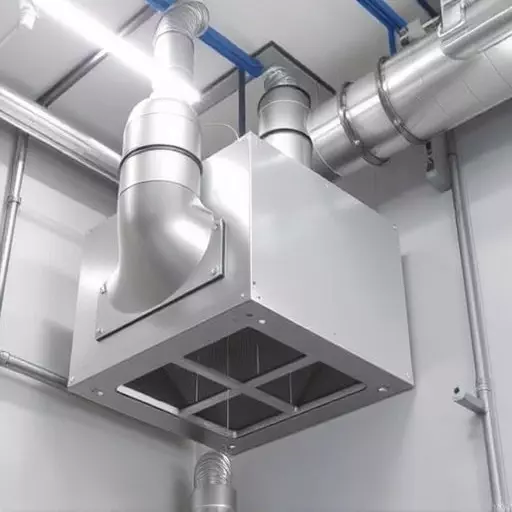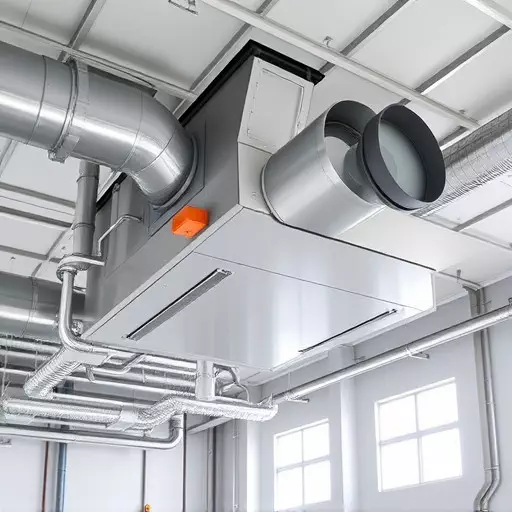Industrial facilities require tailored industrial ventilation solutions balancing exhaust ventilation solutions and supply ventilation systems for worker safety, productivity, and environmental compliance. Unique process demands dictate specific emissions management strategies, while efficient equipment placement relies on facility layout. Key factors include selecting the right combination of exhaust and supply systems to meet operational needs. Integrating smart technology optimizes airflow, improves air quality, reduces energy use, enhances worker comfort, and boosts system reliability through remote monitoring and predictive maintenance.
In today’s industrial landscape, efficient and smart ventilation systems are no longer a luxury—they’re an imperative. This article explores the multifaceted world of industrial ventilation solutions, delving into the challenges and benefits of exhaust ventilation solutions and supply ventilation systems. We’ll uncover how integrating smart technology is revolutionizing air quality management, enhancing worker safety, and boosting operational efficiency across industries. By the end, you’ll grasp the transformative power of innovative ventilation solutions.
- Understanding Industrial Ventilation Needs: Identifying Key Challenges
- The Role of Exhaust Ventilation Solutions in Worker Safety and Efficiency
- Exploring Supply Ventilation Systems: Enhancing Indoor Air Quality
- Integrating Smart Technology: Revolutionizing Industrial Ventilation Solutions
Understanding Industrial Ventilation Needs: Identifying Key Challenges

Industrial facilities face unique challenges when it comes to ventilation, as efficient air movement and quality are essential for worker safety, productivity, and environmental compliance. Understanding these needs is crucial in designing effective industrial ventilation solutions. One of the primary challenges is determining the appropriate balance between supply ventilation systems and exhaust ventilation solutions. Factories often require robust exhaust systems to remove harmful pollutants and maintain safe working conditions, while also needing sufficient supply ventilation to provide fresh air and prevent stagnant environments.
Another key consideration is the diverse range of industrial processes and their varying requirements. Different manufacturing processes generate distinct types of emissions, requiring tailored ventilation strategies. For example, certain industries may need specialized systems for handling toxic gases or particulate matter, which necessitates a comprehensive assessment of the facility’s specific needs. Additionally, the layout and design of the workplace play a significant role in determining the most efficient placement of ventilation equipment to address hot spots and ensure uniform air distribution.
The Role of Exhaust Ventilation Solutions in Worker Safety and Efficiency

Industrial environments often present unique challenges when it comes to maintaining optimal air quality and ensuring worker safety. This is where exhaust ventilation solutions play a pivotal role. By designing effective industrial ventilation systems, businesses can significantly enhance both productivity and employee well-being. Efficient exhaust ventilation removes hazardous or noxious gases, fumes, and dust particles from the workspace, creating a healthier and safer environment.
In many industries, such as manufacturing, automotive, and pharmaceutical production, supply ventilation systems are essential to control temperature, humidity, and air movement. These systems not only improve overall workplace efficiency but also reduce the risk of respiratory issues, skin irritation, and other health problems that may arise from prolonged exposure to contaminated indoor air. Well-planned industrial ventilation solutions contribute to a more comfortable and productive work environment, fostering employee satisfaction and retention.
Exploring Supply Ventilation Systems: Enhancing Indoor Air Quality

Supply ventilation systems play a pivotal role in enhancing indoor air quality within industrial settings. These advanced industrial ventilation solutions are designed to introduce fresh outdoor air into enclosed spaces, thereby improving overall air purity and comfort for workers. By strategically placing supply vents, businesses can effectively dilute and replace contaminated indoor air with cleaner alternatives, which is particularly crucial for maintaining optimal health and safety conditions in factories and workshops.
Unlike traditional exhaust ventilation solutions that primarily remove pollutants, supply systems actively draw in fresh air, ensuring a continuous flow of clean gases. This dual approach not only reduces the concentration of hazardous substances but also prevents stagnant air pockets from forming. As a result, employees are less likely to breathe in potentially harmful particles or gases, leading to improved productivity and well-being. Efficient industrial ventilation solutions can be tailored to meet the specific needs of various industries, offering enhanced control over indoor environments.
Integrating Smart Technology: Revolutionizing Industrial Ventilation Solutions

Integrating smart technology has brought about a revolution in the realm of industrial ventilation solutions. Traditional exhaust and supply ventilation systems are being transformed into efficient, intelligent networks that adapt to real-time conditions. Sensors, connected devices, and data analytics enable these advanced systems to optimize airflow, improve indoor air quality, and reduce energy consumption.
By leveraging smart technology, industries can now implement more effective strategies for managing temperature, humidity, and pollution levels. This not only enhances worker comfort and safety but also contributes to significant cost savings through optimized energy use. Moreover, the ability to monitor and control ventilation systems remotely opens up possibilities for predictive maintenance, reducing downtime and increasing overall system reliability.


